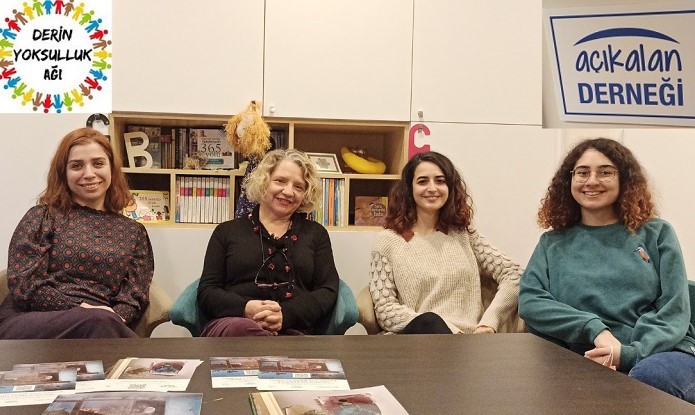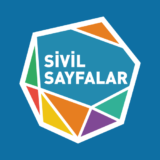Deep Poverty Network: A Successful Model of Solidarity in Fighting Poverty

The concept of "deep poverty" has been used more and more frequently in the last few years, and has made it to the public agenda thanks to the highly appreciated efforts by Deep Poverty Network (Derin Yoksulluk Ağı: DYA). DYA's Hacer Foggo, Şeyma Duman, Şevval Şener and Selen Yüksek describe deep poverty as a state of futurelessness passed down from generation to generation, and employ the term "hunger" to describe the current state of poverty aggravated by the pandemic.
How would you describe Deep Poverty Network in brief? What does the network do?
Şevval: Volunteers and members of the Open Space Association and Çimenev launched the Deep Poverty Network (DYA) in December 2019. DYA was initially established to study poverty among poor families which we had been supporting over the years. Yet with the onset of the pandemic in March 2020, we had to shift our focus from the initial goal of studying poverty to poverty relief. As families started to contact us, DYA initiated its first activity, a solidarity campaign to support individuals who cannot access food. While setting up DYA, we wanted to explore the causes of deep poverty and possible solutions, and also to assist people in need through urgent intervention. DYA is currently continuing these two efforts at the same time.
How do you describe Deep Poverty Network in institutional terms?
Selen: We constitute a vast network of solidarity together with our supporters, volunteers, and families receiving support. We operate under the umbrella of the Open Space Association. In every sense, we are an organization active in the field of civil society.
How can one fight against multidimensional poverty or deep poverty?
Hacer: People sometimes tell us that “Helping single individuals cannot the solution.” Yet we have already reached 2,500 families. Here is the gist of the matter: The Ministry of Education stated that 1.5 million students do not have internet access in Istanbul, in March last year. This is huge number. What has been done in the meantime to resolve this issue?
In response to people arguing that “the real solution is to teach them how to fish”, I say this: A lot of kids won’t go to school in the next school year; this is obvious. You don’t have to be a seer to predict that. We must ensure that these poor kids keep going to school. If these children drop out, this new brand of poverty, that is, deep poverty or chronic poverty will continue further. These children must attend school.
Sometimes people don’t get it: The pandemic has changed the whole picture. The only thing to do now is to make sure that these people have access to food, and satisfy their 4 basic needs. Under the current conditions, providing employment is nearly impossible. Unemployment is soaring across Turkey. We cannot just sit down and say “this is a problem of the system”, and watch these people go hungry.
During the pandemic, for say two years, we must instead seek answers to the question, how can we meet the basic needs of people in deep poverty; and what can we achieve together?
Şevval: We can’t just say that poverty is a problem created by the system and do nothing. We are in direct contact with these people; they really can’t eat, and go hungry. There has to be an urgent intervention.
Selen: We are all faced with fundamental problems as we are trying to survive. Of course, the ultimate solution would be to create a sustainable, new order, by transforming the structure through policy-based change…
Şeyma: This is probably what we call the DYA model: As those who do not accept the current situation, we must try to transform our thought system, the relation of aid provider and aid recipient or the giving hand and the receiving hand, starting from our very discourse and mind set, during the pandemic… This is the model we stick to in DYA; that is, upholding a rights-based perspective.
“The Difference Between the Pre-Pandemic Period and Now: Hunger”
How would you describe the pandemic’s impact on poverty? What is the difference between the pre-pandemic period and today?
Hacer: The difference between the past and present is, in a single word, hunger. I have been working among communities in deep poverty for over two decades. We used to engage in organizing work among these groups, establishing centers like Çimenev; but I have never encountered such a level of lack of food, deep hunger, and chronic scarcity.
Does the Deep Poverty Network present a model in the fight against poverty? How would you position yourselves?
Hacer: I think we have already constituted a model. We have started to discuss the concept of deep poverty. This is a model by itself. In addition, we have rendered visible these families, namely, the invisible communities in deep poverty. This is a model in itself.
There are stereotypical discourses on poverty across society; mostly politicians, and also sometimes NGOs employ such discourses. During every election period, political parties make various remarks on poverty. We try to show that their perspective is not correct, and that there is a story beneath all this. These individuals are constantly marginalized; we establish a relation of aid giver and aid receiver without really knowing them, simply by providing them relief at certain periods, and taking photos to show “I offered aid”.
At DYA, we have shown that this should not continue and that reality is totally different. We have always examined the issue through a rights-based perspective. We have explained that we should not establish a relation of obedience or subservience. This is our model. And I think that we open up a debate through our arguments and practices.
Şevval: At DYA, we will continue to organize activities to empower these communities. I believe that all this will help us make progress.
Hacer: We must gather everyone around the table to complete the model. Such a model can emerge only when everyone interested in this issue, and the people of poor communities sit around the table.
Selen: I think that DYA is not a model by itself, but it can provide a starting point to build such a model. We don’t claim, “We will find the solution to poverty in Istanbul”. We simply think that we can create a model by bringing together all the stakeholders.
Hacer: Sometimes we hear talk of establishing DYA chapters in other cities, but we do not have such a goal. On the contrary, we would rather support friends who want to organize solidarity in their cities. Sometimes people ask, “how can we help you?”. A lot of things can be done to help us. But we basically say that, everyone should do something in their own community. There is certainly someone in need, whether in your building or in your community. The important thing is to change your perspective and adopt such a point of view. Support someone in need that you come across on the street… This is the real model.
How can people access the Deep Poverty Network?
Şevval: They may reach us via our Twitter and Instagram accounts. Also, there is an e-mail address on our web site. Currently we are working on a software. Once we launch this software, we will automate the system, and it will be possible for us to distribute aid without people having to contact us via social media.

Bizi Takip Edin